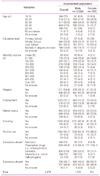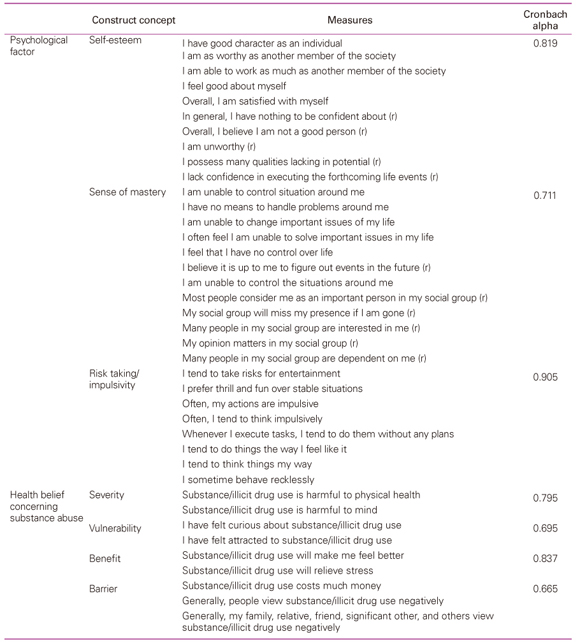Abstract
The aim of this research was to assess the influence of social-demographic, psychological, health beliefs, and social environmental factors on the substance use in each gender group. Greater knowledge concerning these issues may help public health and medical policy-makers design more effective means for preventing substance abuse. Logistic regression analyses of the 2005 Korean Institute of Criminology Survey were conducted for exploring gender-specific factors in the sample of 1,332 male and 131 female prisoners. Prevalence for substance abuse was 49.5% of men and 50.1% of women. For both men and women, social environment factor such as drug use by family and friends was associated with substance abuse (odds ratio [OR], 2.738 for men; OR, 5.072 for women; P<0.01). Perceived severity (OR, 0.816 for men; OR, 0.839 for women; P<0.01) and perceived vulnerability (OR, 1.149 for men; OR, 1.215 for women; P<0.01) were also factors contributing to substance abuse. Among women, depression and impulsive behavior increased the risk of substance use. Men, on the other hand, age, no religion, and smoking were the risk factors of substance use. We find support for the current argument that there are differences in contributing factors in each gender group in regards to the risk of substance abuse. Our findings suggest that there is a need to develop appropriate health communication and policy intervention strategies for substance abuse prevention and treatment for gender specified groups at greater risk.
References
1. Lee SS. The effects of strain and depression on adults' drug abuse: an integrated approach. Korean J Criminol. 2006. 18:325–349.
2. Dodge K, Potocky-Tripodi M. The effectiveness of three inpatient intervention strategies for chemically dependent women. Res Soc Work Pract. 2001. 11:24–39.

3. Langan NP, Pelissier BM. Gender differences among prisoners in drug treatment. J Subst Abuse. 2001. 13:291–301.

4. Galea S, Nandi A, Vlahov D. The social epidemiology of substance use. Epidemiol Rev. 2004. 26:36–52.

5. Thom B. Risk-taking behaviour in men: substance use and gender [Internet]. 2003. cited 2011 Dec 14. London: National Institute for Health and Clinical Excellence;Available from: http://www.nice.org.uk/nicemedia/documents/men_at_risk_01-04-03.pdf.
6. Merline AC, O'Malley PM, Schulenberg JE, Bachman JG, Johnston LD. Substance use among adults 35 years of age: prevalence, adulthood predictors, and impact of adolescent substance use. Am J Public Health. 2004. 94:96–102.

7. Grella CE, Joshi V. Gender differences in drug treatment careers among clients in the national Drug Abuse Treatment Outcome Study. Am J Drug Alcohol Abuse. 1999. 25:385–406.

8. Riehman KS, Hser YI, Zeller M. Gender differences in how intimate partners influence drug treatment motivation. J Drug Issues. 2000. 30:823–838.

9. Messina NP, Burdon WM, Prendergast ML. Assessing the needs of women in institutional therapeutic communities. J Offender Rehabil. 2003. 37:89–106.

10. Smart RG, Hughes PH, Johnston LD. A methodology for student drug-use surveys [Internet]. 1980. cited 2011 Dec 10. Geneva: World Health Organization;Available from: http://whqlibdoc.who.int/offset/WHO_OFFSET_50.pdf.
11. Donahue MJ, Nielsen ME. Paloutzian R, Park CL, editors. Religion, attitudes, and social behavior. Handbook of the psychology of religion and spirituality. 2005. New York: Guilford Press;274–991.
12. Engs RC, Mullen K. The effect of religion and religiosity on drug use among a selected sample of post secondary students in Scotland. Addict Res Theory. 1999. 7:149–170.

13. Abraham HD, Fava M. Order of onset of substance abuse and depression in a sample of depressed outpatients. Compr Psychiatry. 1999. 40:44–50.

14. Curran PJ. Rose J, Chassin L, Presson CC, Sherman SJ, editors. A latent curve framework for the study of developmental trajectories in adolescent substance use. Multivariate applications in substance use research: new methods for new questions. 2000. New Jersey: Lawrence Erlbaum Associates;1–42.
15. McDowell DM, Clodfelter RC. Depression and substance abuse: considerations of etiology, comorbidity, evaluation, and treatment. Psychiatr Ann. 2001. 31:244–254.

16. Ross HE, Glaser FB, Germanson T. The prevalence of psychiatric disorders in patients with alcohol and other drug problems. Arch Gen Psychiatry. 1988. 45:1023–1031.

17. Griffin ML, Weiss RD, Mirin SM, Lange U. A comparison of male and female cocaine abusers. Arch Gen Psychiatry. 1989. 46:122–126.

18. Zilberman ML, Tavares H, Blume SB, el-Guebaly N. Substance use disorders: sex differences and psychiatric comorbidities. Can J Psychiatry. 2003. 48:5–13.

19. Schroeder DS, Laflin MT, Weis DL. Is there a relationship between self-esteem and drug use? Methodological and statistical limitations of the research. J Drug Issues. 1993. 23:645–665.

20. Aguirre-Molina M, Gorman DM. Community-based approaches for the prevention of alcohol, tobacco, and other drug use. Annu Rev Public Health. 1996. 17:337–358.

21. Radloff LS. The CES-D scale: a self-report depression scale for research in the general population. Appl Psychol Meas. 1977. 1:385–401.
22. Luhtanen R, Crocker J. A collective self-esteem scale: self-evaluation of one's social identity. Pers Soc Psychol Bull. 1992. 18:302–318.

23. Pearlin LI, Lieberman MA, Menaghan EG, Mullan JT. The stress process. J Health Soc Behav. 1981. 22:337–356.

24. Paulhus DL, Selst MV. The spheres of control scale: 10 yr of research. Pers Individ Dif. 1990. 11:1029–1036.

25. Zuckerman M. Sensation seeking: beyond the optimal level of arousal. 1979. Hillsdale: Erlbaum Publications.
26. Thombs DL, Beck KH, Mahoney CA, Bromley MD, Bezon KM. Social context, sensation seeking, and teen-age alcohol abuse. J Sch Health. 1994. 64:73–79.

27. Rosenstock IM. Historical origins of the health belief model. Health Educ Monogr. 1974. 2:328–335.

30. Becker MH, Maiman LA, Kirscht JP, Haefner DP, Drachman RH. The health belief model and prediction of dietary compliance: a field experiment. J Health Soc Behav. 1977. 18:348–366.

31. Becker MH, Radius SM, Rosenstock IM, Drachman RH, Schuberth KC, Teets KC. Compliance with a medical regimen for asthma: a test of the health belief model. Public Health Rep. 1978. 93:268–277.
32. Kline A. Pathways into drug user treatment: the influence of gender and racial/ethnic identity. Subst Use Misuse. 1996. 31:323–342.

33. Primavera LH, Pascal R. A comparison of male users and nonusers of marijuana on the perceived harmfulness of drugs. Am J Drug Alcohol Abuse. 1986. 12:71–77.

34. Kim JH, Yoon YM. The effects of communication experiences as negative cues to action on attitude toward drug abuse: modifying health belief model. Korean J Journal Commun Stud. 2010. 54:5–31.
35. Kandel D, Yamaguchi K. From beer to crack: developmental patterns of drug involvement. Am J Public Health. 1993. 83:851–855.

36. Torabi MR, Bailey WJ, Majd-Jabbari M. Cigarette smoking as a predictor of alcohol and other drug use by children and adolescents: evidence of the "gateway drug effect". J Sch Health. 1993. 63:302–306.

37. Richter KP, Ahluwalia HK, Mosier MC, Nazir N, Ahluwalia JS. A population-based study of cigarette smoking among illicit drug users in the United States. Addiction. 2002. 97:861–869.

38. Akers RL, Krohn MD, Lanza-Kaduce L, Radosevich M. Social learning and deviant behavior: a specific test of a general theory. Am Sociol Rev. 1979. 44:636–655.

39. Brook JS, Whiteman M, Finch SJ, Cohen P. Young adult drug use and delinquency: childhood antecedents and adolescent mediators. J Am Acad Child Adolesc Psychiatry. 1996. 35:1584–1592.

40. DeWit DJ, Silverman G, Goodstadt M, Stoduto G. The construction of risk and protective factor indices for adolescent alcohol and other drug use. J Drug Issues. 1995. 25:837–864.

41. Elliott DS, Huizinga D, Ageton SS. Explaining delinquency and drug use. 1985. Beverly Hills: Sage Publications;176.
42. Hirschi T. Causes of delinquency. 2002. New Brunswick: Transaction Publishers;309.
43. Hser YI, Anglin MD, McGlothlin W. Sex differences in addict careers. 1. Initiation of use. Am J Drug Alcohol Abuse. 1987. 13:33–57.

44. Blume SB. Chemical dependency in women: important issues. Am J Drug Alcohol Abuse. 1990. 16:297–307.

45. Currie SR, Patten SB, Williams JV, Wang J, Beck CA, El-Guebaly N, Maxwell C. Comorbidity of major depression with substance use disorders. Can J Psychiatry. 2005. 50:660–666.

46. Schaar I, Ojehagen A. Severely mentally ill substance abusers: an 18-month follow-up study. Soc Psychiatry Psychiatr Epidemiol. 2001. 36:70–78.

47. Christie KA, Burke JD Jr, Regier DA, Rae DS, Boyd JH, Locke BZ. Epidemiologic evidence for early onset of mental disorders and higher risk of drug abuse in young adults. Am J Psychiatry. 1988. 145:971–975.

48. Turner RJ. Social support as a contingency in psychological well-being. J Health Soc Behav. 1981. 22:357–367.

49. Turner RJ, Frankel BG, Levin DM. Simmons RG, editor. Social support: conceptualization, measurement, and implications for mental health. Research in community and mental health. 1983. Greenwich: JAI Press Inc.;67–111.




 PDF
PDF ePub
ePub Citation
Citation Print
Print





 XML Download
XML Download